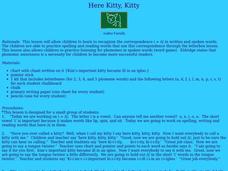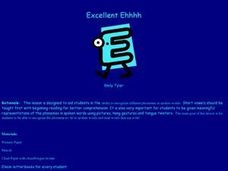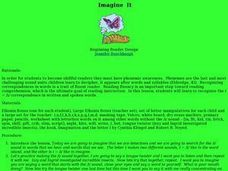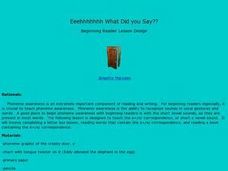Curated OER
Gulp, Gulp, Gulp!
Students recognize the grapheme g in its upper and lower case form. They produce the corresponding sound for the letter g. Students go over what shape your mouth makes and how the back of your throat moves when making the sound for g.
Curated OER
Ssslithering Ssssnake
Pupils examine the letter 's'. Through instruction and modeling they explore the sound the letter makes, how the letter is written, words that contain the letter, etc. They listen to a story and identify words with the /s/ sound by...
Curated OER
Say What?
Students explore phonemes in spoken words. They discuss the /e/ (short e) correspondence. Students read "Red Gets Fed." They learn a meaningful letter symbol for the /e/. Students identify /e/ sound in both spoken and written words.
Curated OER
Look at that BIG PIG!!!
First graders give examples of words that have the /i/ sound. They make the /i/ sound with their mouths and follow along as the poster is read which contains /i/ words. They read the poster together stretching out the /i/ sound and...
Curated OER
"Aaa-Aaa-Aaa-Choo!!"
Students study /a/ in written and spoken words. They make sneeze sounds, recite a tongue twister, and write the letter /a/. Next, they listen to a book talk about 'Pat's Jam' before listening to the story and making the sneezing movement...
Curated OER
"Ahhh" Says the Doc
Students complete a variety of activities as they explore/review the letter 'o' as it makes the short /o/ sound. They recite short /o/ tongue twisters, practice writing 'o' words using letterboxes, and listen to stories, identifying...
Curated OER
Chicka-Chicka-Boom-Boom
Students review the "ch" digraph in this lesson. Students identify words that have the "ch" sound, and practice writing the digraph. Students then listen to the story "Chicka-Chicka-Boom-Boom" and identify the words in the book with the...
Curated OER
"Loud Cows All Around"
Students practice with vowel digraphs and how letters can correspond with phonemes. The activity consists of students learning the ou=/ow/ correspondence in which they will learn in both spoken and written words through reading and...
Curated OER
Quick, Quack, Quick Went The Duck
Pupils practice recognizing the phonemes and diagraphs in letters that blend together to form the "ck" sound. They interact with the book, "Quick, Quack, Quick!" by Marsha Arnold and the phrase, "Jack the duck found an icky sticky chick...
Curated OER
Egg-stra!! Egg-stra!!
Students recognize the short vowel e in written and spoken language. Through matching activities, they discriminate the short vowel /e/ from other phonemes. Students associate the phoneme with its letter representation and identify the...
Curated OER
Boom Chicka Boom
Students recognize how vowel patterns change a short vowel sound into a long vowel sound. With an emphasis on the /oo/ that makes the long U sound, students identify the phoneme and letter combination through listening and matching...
Curated OER
Here Kitty, Kitty
Learners recognize the short vowel i in written and spoken language. Through matching activities, they discriminate the short vowel /i/ from other vowel sounds. Students associate the phoneme with its letter representation and identify...
Curated OER
The Very Hungry Caterpillar
Learners explore phonemes and short vowels. They identify /a/ (short a) sound in spoken words and learn a meaningful representation and a letter symbol for the sound. Students identify /a/ (short a) sound in words. They read "The Very...
Curated OER
Iggy is Icky Sticky
Second graders explore short vowels and their help in the development of phonemic awareness. They gain experience of the correspondence /i/. Students illustrate the correspondence by using memorable techniques used in showing /i/ in...
Curated OER
The Ghost Says Boo
Students are introduced to the vowel pattern that produces the /oo/ sound in words. Through matching, listening, and spelling activities, students recognize the phoneme /oo/ and its placement in words. They read a passage with words...
Curated OER
Excellent Ehhhh
Students make the different e sounds and practice a chant about the e sounds. They use a letterbox to write different words utilizing the e sounds. They listen to a story about a dog named Red that emphasizes the e sound. They write a...
Curated OER
Imagine It
Students become skillful readers by assessing phonemic awareness and deciphering the words and syllables that follow challenging sounds. This activity emphasizes the correspondence dealing with the i=/i/ in written and spoken words.
Curated OER
Literal Meaning of Reading
Students demonstrate literal meaning of a fiction book. In this reading comprehension lesson, students listen to the book, If You Give a Mouse a Muffin and practice the "m" sound during the read aloud. Students answer questions about the...
Curated OER
Sammy the Slimy Snake
Young scholars engage in a emergent literacy instructional activity with the intention of improving reading comprehension. The goals of the instructional activity include recognizing both upper and lower case S, to create an awareness of...
Curated OER
The Door is Creaky E
Students observe the prop of a door to demonstrate the sound of the phonemic sound of the letter "e". Then they drill and practice the sound with the teacher. The essential importance of the skill of phonemic awareness is stressed in the...
Curated OER
Iggy and the Icky Sticky Inchworm
Students read and spell words. They have to recognize that letters stand for phonemes and spellings map out spoken words. Long and short vowels are hard to recognize and this lesson focuses on that. The short i is taught in the...
Curated OER
Eeehhhhhhh What Did you Say??
Student read pseudo words containing the e=/e/ correspondence and recognize sounds in vocal gestures and words. They explore the e=/e/ correspondence, or short e vowel sound and complete a letter box lesson, reading words that contain...
Curated OER
Icky, Sticky!!
Students participate in an emerging literacy lesson that focuses on the skill of phonemic awareness. The phoneme of choice is the letter "i". Students need to recognize the letter in correlation to its sound.
Curated OER
Pretty, Pretty Queen!
Students identify and listen for the beginning sounds of words (specifically p and q). They recognize and comprehend the differences between p=/p/ and q=/kw/. Students practice writing p and q and also looking for them and listening for...

























